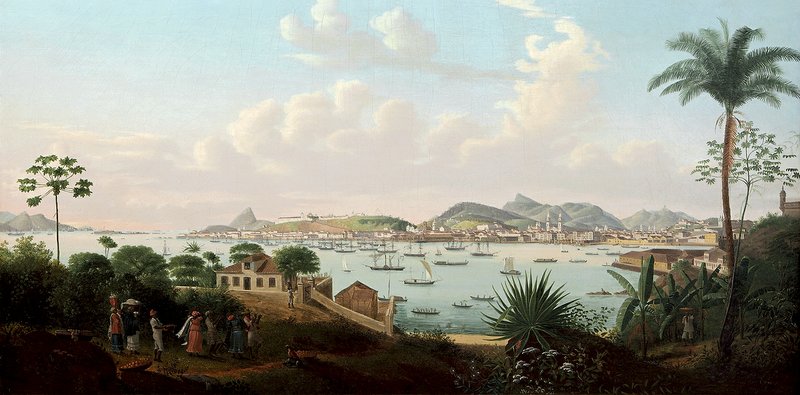For the untrained eye, it might be hard to see the power of a landscape painting.
But in reality, landscapes have a unique use as cultural snapshots and a way to view history through topography. Recently opened exhibit, "Picturing the Americas," at Crystal Bridges Museum of American Art in Bentonville explores that rich, cultural history through 100 oil paintings, watercolors and prints created by artists and explorers from Canada, the United States, Mexico and other countries in South America.
Picturing the Americas
WHEN: On display through Jan. 18
WHERE: Crystal Bridges Museum of American Art, Bentonville
COST: $10 general admission, free for members and youth (younger than 18)
INFO: crystalbridges.org or 418-5700
Seeing so many landscapes from the 19th and 20th centuries in one place brings to mind what similarities transcend the border of countries, and what makes each one unique.
"It's fascinating to think about [it through] our own traditions," says Peter John Brownlee, curator of the Terra Foundation for American Art. Brownlee co-curated the exhibit with Valeria Piccoli and Georgiana Uhlyarik, curators from Sao Paulo, Brazil, and Ontario, Canada, respectively. When you look at these paintings, you think "'How are we separate?' 'How are we distinct?' 'What is our shared history?'"
The exhibit is broken down into three sections, but the paintings weren't divided by country or location. It made more sense to put them into thematic categories, so visitors could see the issues people have across state lines.
"We wanted to bring the two icy tips of the continent together," says Uhlyarik, associate curator of Canadian art at the Art Gallery of Ontario. "We didn't want people to just recognize the iconic [landscape paintings], we wanted them to focus on cultural identity and understand, socially, how nations developed over time."
"All sections of the exhibit speak to what we share," says Piccolia, chief curator of the Pinacoteca do Estado de Sao Paulo.
In the first gallery, landscapes are a beautiful way to capture "Battles, Borders, Territories"-- the political divides in scenic locations. If it's hard to picture an artist and easel along lines of soldiers, you'd be right in your skepticism.
During the late 1800s and early 1900s, most artists weren't allowed into war zones or the frontier where battles were fought, but they found ways to depict the rapidly changing national history anyway.
In a South American painting, for example, men are riding horses, carrying guns and flags while headed to something the viewer can't see beyond a hill. Similarly, in "The Red River Expedition at Kakabeka Falls," artist Frances Anne Hopkins depicts a large crowd of men in boats who are docking, unloading and heading off to battle, presumably.
"Many of these show the ideal of nature in the way the land was accumulated," Uhlyarik says. "There's a unique personality that nature has in conflicts."
The middle gallery focuses on the value of the "Land as Resource," which uses the depiction of people with and crossing the land as practical ways of moving those resources and as a way to lament the extraction of ice, lumber, crops and other commodities.
In fact, artists even used images of themselves to put the alterations happening within the landscape into context. The painting "Montemorency Falls" by Cornelius Kreighoff centers on a frozen arc of a waterfall in Canada with sledding and sleigh-riding people milling at the base; and the image was made many times over. The artist would sit at the base of the falls, the painting displayed, and offer to recreate the scene with the faces of your family members in those tiny visitors at the bottom. Frances Hopkins put herself in one of the canoes of "The Red River," too.
"Artists putting themselves in paintings makes them the median," Brownlee says. Even the landscape painting itself is a way to capture the aesthetic value we can all appreciate. "It's a way of pulling the beauty of the world out of a natural space and into culture."
As transportation improved and notions of what was acceptable in the art world changed, "it inspired artists to go into nature," Uhlyarik says. The viewer can see that in Land as Resource, the curators say, because there's a difference in painting something you've experienced and something you've never laid eyes on.
The artists whose work is depicted in Picturing the Americas "established the [practice] of traveling to see something and then painting," Piccolia says. Many of them were naturalists, members of the military and diplomats -- all had artistic training.
The final gallery, "Land Transformed," has a more noticeable shift away from traditional flora, fauna and wide shots of vast land. It focuses instead on what's become of the land since early exploration and the industrial era. Buildings and warehouses appear. A map of the Americas shows South America on "top," the artist's way of saying "right side up." And mostly, the depiction of nation becomes more personal and interpretative.
The curation is bold in bringing together works that have never before been shown in tandem.
"We wanted to put artists together who would never put themselves together," Uhlyarik says. "They're all in one place. We wanted to understand what would happen here and a way [for these countries, peoples] to be connected."
NAN What's Up on 11/20/2015

